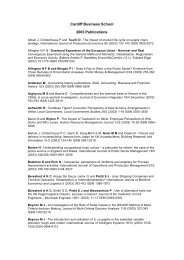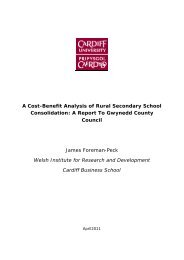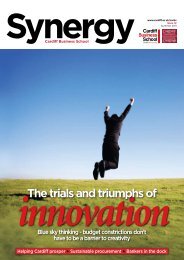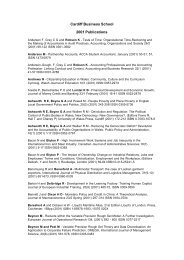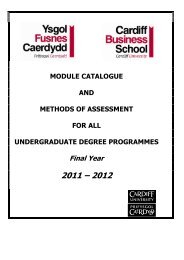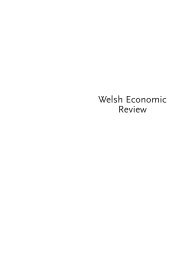Revisiting the Great Moderation using the Method of Indirect Inference
Revisiting the Great Moderation using the Method of Indirect Inference
Revisiting the Great Moderation using the Method of Indirect Inference
Create successful ePaper yourself
Turn your PDF publications into a flip-book with our unique Google optimized e-Paper software.
Table 13: `Taylor Rules' in <strong>the</strong> Data (with OLS): consistency with <strong>the</strong> estimated Timeless<br />
Rule Model<br />
Panel A: `Taylor Rules' in <strong>the</strong> <strong>Great</strong> Acceleration<br />
`Taylor Rule' versions x Adj.R 2 Wald percentiles<br />
~{ t = t + x x t +~{ t 1 + t 0.09 0.06 0.90 0.84 31.9<br />
~{ t = t + x x t + t<br />
t = t 1 +" t<br />
0.30 0.07 0.92 0.85 69.1<br />
~{ t = t 1 + x x t 1 + t 0.60 -0.01 n/a 0.24 36.9<br />
~{ t = t 1 + x x t 1 +~{ t 1 + t -0.11 0.06 0.82 0.83 68.5<br />
Panel B: `Taylor Rules' in <strong>the</strong> <strong>Great</strong> <strong>Moderation</strong><br />
`Taylor Rule' versions x Adj.R 2 Wald percentiles<br />
~{ t = t + x x t +~{ t 1 + t 0.08 0.05 0.89 0.92 11.5<br />
~{ t = t + x x t + t<br />
t = t 1 +" t<br />
0.07 0.06 0.93 0.90 95.6<br />
~{ t = t 1 + x x t 1 + t 0.26 0.13 n/a 0.24 17.1<br />
~{ t = t 1 + x x t 1 +~{ t 1 + t 0.03 0.04 0.89 0.91 89.7<br />
biased by <strong>the</strong> non-stationarity <strong>of</strong> <strong>the</strong> interest rate. There is little statistical dierence in<br />
<strong>the</strong> estimates across <strong>the</strong> two periods. The reported Wald percentiles indicate that <strong>the</strong>se<br />
empirical 'Taylor Rules' are indeed consistent with what <strong>the</strong> Timeless Rule implies: in<br />
both panels <strong>the</strong> Taylor Rule regressions estimated are all within or on <strong>the</strong> 95% condence<br />
bounds implied by <strong>the</strong> estimated Timeless Model.<br />
This illustrates <strong>the</strong> identication problem with which we began this paper: a Taylor<br />
Rule regression having a good t to <strong>the</strong> data may well be generated by a model where<br />
<strong>the</strong>re is no structural Taylor Rule at all. Here we suggest that <strong>the</strong> Timeless Rule model<br />
we have found gets closest to tting US data in each episode is also generating <strong>the</strong>se<br />
Taylor Rule single-equation relationships.<br />
35



